Community and Chamber Welcome New Commander at NSWC Corona
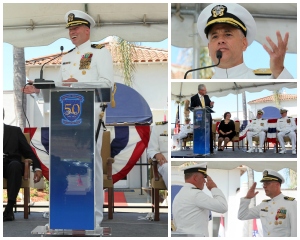
The community recently welcomed Capt. (sel) Stephen Murray as he assumed command of the Naval Surface Warfare Center (NSWC), Corona Division at a ceremony featuring Rear Adm. Lawrence Creevy, commander of the U.S. Navy’s Naval Surface Warfare Center.
The Naval Surface Warfare Center (NSWC), Corona Division recently announced a new Commanding Officer, Captain Stephen H. Murray. Captain Murray will replace Captain Eric H. Ver Hage who has led NSWC Corona since November 2011. The Chamber welcomes and congratulates Captain Murray on his new position with the Naval facility.
NSWC Corona is the Navy’s only independent assessment agent, and is responsible for gauging the warfighting capability of Navy ships and aircraft. It also provides critical warfighter support to the Navy and Marine Corps as the range systems and engineering agent, and helps sustain aircrew training around the world.
This local military installment is a high-tech center for science and engineering and a strong economic driver in our region. It has a $300 million economic impact to the regional economy, employs 1,500 local civilians, and hosts more than 7,000 visitors every year.
Captain (sel) Murray joins NSWC Corona as the Deputy Major Program Manager for the Ship Self Defense System in Program Executive Officer for Integrated Warfare Systems at the Naval Sea Systems Command (NAVSEA).
Murray enlisted in the Navy in 1986 and was commissioned through Officer Candidate School in 1991. He has completed numerous afloat and ashore tours, including 14 years at sea with Middle East deployments and a command tour with Maritime Expeditionary Security Squadron SIX, where he deployed to Haiti after the 2010 earthquake and to the United Arab Emirates.
Other ashore tours include Country Program Director at the Navy International Programs Office and as a Federal Executive Fellow at the Brookings Institution where he researched the trends in replacing the labor force in the United States shipbuilding industry.
He recently completed an assignment as a Branch Head on the staff of the Director for Surface Warfare (OPNAV N96) where he sponsored the Ship Self Defense System, Navigation, and Air Warfare Enterprise Test and Evaluation programs.
Many distinguished visitors, military members and prominent community leaders as well as local and state legislative officials were in attendance to welcome Captain Murray at the Change of Command ceremony on August 1. The Chamber looks forward to building a strong relationship with Captain Murray and thanks Captain Ver Hage for his unwavering efforts to keep NSWC Corona a forerunner in the high-tech industry.
The Chamber has partnered with business and building industries to caution County leaders on potential increases to Development Impact Fees (DIF) on new development in Riverside County. The Chamber stressed that the increase of fees will endanger the growth achieved so far. The County of Riverside Board of Supervisors reviewed these fees late July and the Chamber will continue to engage in this process.
In particular, the Chamber stressed that the drastic increase in DIF fees in commercial, industrial, and manufacturing sectors in the Highgrove, Northside, and University City area as well as the Woodcrest and Lake Matthews area would be detrimental to future development in those areas.
While local businesses and development have demonstrated some signs of improvement in recent years, they are still heavily impacted by factors such as fees, labor costs, and other unfavorable influences. Although the proposed increase in DIF fees would be below those collected by other surrounding counties, they do not take into account the imposition of Transportation Uniform Mitigation Fees (TUMF) which are unique to Riverside County and its incorporated communities. Imposing an increase in DIF fees would unnecessarily jeopardize the encouraging growth the region has seen to date.
The Chamber also encouraged the Board to consider an extended phase-in process to allow local businesses greater time and opportunity to adjust to these changes. While the revenue generated from these fees will assist the County in performing other critical functions in public safety and others areas, the significant and arbitrary increase of DIF fees in commercial, industrial, and manufacturing sectors seems to negatively impact sectors that need the most encouragement.
Moreover, the Chamber has been working closely with the County of Riverside and other partners to incentivize other new growth and initiatives through supporting grant applications, connecting the region to other economic partners the iHub designation and bringing economic development incentives to the region through the California Economic Development Initiative.
The Chamber will continue to work with the County of Riverside and other public partners to incentivize local development and economic growth rather than impose potentially detrimental fee increases. For more information, contact Nicholas Adcock at 951-683-7100 ext. 217.

Chamber-opposed SB 935 was recently stopped in an Assembly policy committee. The bill seeks to raise the minimum wage on businesses that are already facing increasing costs.
Thanks to the work of local business leaders in Riverside and across California, SB 935, a Chamber-opposed bill that would increase the minimum wage and tie future increases to the Consumer Price Index, was recently blocked in the California State Assembly’s Labor and Employment Committee. Employers are already facing rising costs in several other places and a minimum wage increase would likely result in a reduction in jobs.
Automatically indexing the minimum wage to inflation, as SB 935 proposes, has always been troubling to the business community because it fails to take into consideration other economic factors or cumulative costs to which employers may be subjected. Employers are already facing significant cost increases over the next several years, including higher taxes under Proposition 30, increased Workers’ Compensation rates, loss of federal unemployment insurance credit, increased energy costs, and increased costs associated with the implementation of the Affordable Healthcare Act.
There will undoubtedly be other costs employers are struggling with in 2018 when SB 935 seeks to tie the minimum wage increase to inflation. These unknown costs, coupled with an unknown economy at that time or thereafter, create concern and uncertainty for businesses.
Moreover, placing the increase in minimum wage on auto-pilot is inappropriate when California has a full-time Legislature available and responsible for reviewing whether any adjustment in wages is proper given the state of the economy at that point.
Although SB 935 failed passage in the Assembly Labor and Employment Committee, there is still an opportunity in this legislative term for the bill to make its way through to law. The Chamber thanks all the businesses who reached out to legislators asking for their votes as well as Assemblymembers Luis A. Alejo, Jeff Gorell, Shannon Grove, and Chris Holden for their business-friendly votes on SB 935.
The Chamber will continue to advocate on this bill and others to ensure that local businesses’ bottom lines are protected. For more information, contact Nicholas Adcock at 951-683-7100 ext. 217.
Business, Transportation Secretary Unveils New Developments, Focus for CA Infrastructure
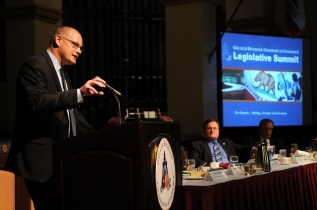
Business, Transportation and Housing Secretary Brian Kelly outlines the Governor’s Reorganization Plan at the Chamber’s 2012 Legislative Summit. Photography courtesy of Michael J. Elderman.
Discussion focused on reforming the California Environmental Quality Act (CEQA) and funding for more infrastructure projects as Chamber members exchanged ideas and priorities with Acting Secretary Brian Kelly of the Business, Transportation and Housing Agency at the Chamber’s 2012 Legislative Summit. Secretary Kelly announced several expected changes to restructure economic development and transportation that will provide better, more effective services to Californians.
In a roundtable prior to the Summit, the Chamber urged the Secretary to push for greater reforms to CEQA’s environmental review process and expediting the delivery of critical infrastructure projects to the region. The discussion also centered on how to continue progress in transportation now that fewer funds exist from Proposition 1B, an approximately $20 billion bond approved by voters in 2006 that has greatly improved congestion relief, goods movement, air quality, and the safety and security of the transportation system.
After the roundtable, Chamber Chairman Brian Hawley of Luminex Software, Inc., stressed, “With Inland Southern California’s explosive population growth, the region needs more infrastructure. We are not just talking about more jobs through construction, but faster transportation corridors will mean greater opportunities for businesses to move goods, expand services, and reach new markets.”
Secretary Kelly stated in his address at the Summit that as of July 1, 2013, the Business, Transportation and Housing Agency will be broken down in specific agencies in order to focus the broad scope of its current objectives. In particular, the new California Transportation Agency, led by a cabinet-level secretary, has the potential to focus on and develop long-term solutions to the state’s funding shortfall for its transportation system. This shift is part of Governor Jerry Brown’s Reorganization Plan, which aims to streamline state governance and service delivery to California residents.
Secretary Kelly stated that the agency would refocus its activities towards the specific goals for transportation and infrastructure development rather than the myriad of responsibilities it currently has. Kelly noted, “We will focus on our areas of expertise and then be able to deliver projects faster and more efficiently.”
In addition, the Reorganization Plan proposes to relocate the California Small Business Development Centers, Infrastructure and Economic Development Bank, the California Film Commission, the Office of Tourism and the Small Business Guarantee Loan Program from the Business, Transportation & Housing Agency into the Governor’s Office of Business and Economic Development (GO-Biz).

The 144th Fighter Wing will continue its mission at MARB, soon to be equipped with F-15 Eagle fighter jets. Inset: The MQ-9 Reaper (pictured) will soon replace the MQ-1 Predator in combat and training missions.
With greater discussion of military cuts and force downsizing in the near future, the Chamber continues to support the unit deployments and active missions at March Air Reserve Base (MARB) and the Naval Surface Warfare Center in Norco and the hundreds of millions of dollars that these facilities bring to the region.
144th Fighter Wing
The Chamber applauded the recent decision by the Department of Defense to maintain the assignment of the California Air National Guard’s 144th Fighter Wing to Fresno Air National Guard Base and March Air Reserve Base. With the support from Senators Dianne Feinstein and Barbara Boxer, the decision also moves one step closer to the successful transition to the F-15 Eagle fighter jets from the F-16 Fighting Falcon aircraft that are currently stationed at both bases. The decision to keep active missions located at March ARB highlights the base’s importance to national defense in possible discussions of military cuts. The 144th Fighter Wing responds to emergency and security calls, including international smuggling, from the Mexican border to Oregon. According to the Department of Defense, the F-15s’ radar systems are better suited to the mission.
Continued RPA Deployment
While the Department of Defense is beginning the transition of remotely piloted aircraft (RPA) from the General Atomics MQ-1 Predator to the General Atomics MQ-9 Reaper for training and combat missions, the Chamber supports the assignment of the MQ-9 Reaper to the 163rd Reconnaissance Wing at MARB. The Department of Defense projects to continue to use the MQ-1 Predator until 2017. The equipping of the 163rd RW with the MQ-9 Reaper will ensure that the five-year buildup of the unit’s training component as well as the funds spent for the development of training and operational facilities will not be wasted.
Under its current mission, the 163rd RW executes combat patrol missions for deployments of the Air National Guard overseas, including recent operations in Iraq and Afghanistan. The 163rd RW has also trained over 160 Predator aircrews in the United States Air Force.
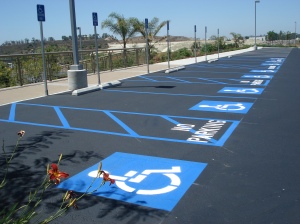
New Chamber-supported legislation would allow businesses to correct special access violations before heading to court.
Responding to concerns from the local business community, the Chamber supported legislation by Senator Bob Dutton that would provide businesses an opportunity to correct violations of noncompliance with the Americans with Disabilities Act before falling victim to frivolous and predatory litigation.
Businesses large and small across the state are reporting instances of receiving letters from attorneys representing disabled clients that are threatening to file litigation for alleged noncompliance violations to provide disability access. These letters often immediately demand payment to settle the dispute, without any follow-up concern for correcting the violation or whether there was even a violation. Furthermore, they require the business to sign a non-disclosure agreement to stop them from warning other establishments from being similarly victimized. Many of these small businesses are making tough decisions to stay afloat and this practice immediately and sometimes irrecoverably impacts their bottom line and their ability to stay in business.
This bill would establish notice requirements for an alleged aggrieved party to follow before bringing a lawsuit against a business for failing to provide disability access. The bill would also allow the business to respond within 30 days with a plan to fix the violation or with a rebuttal to the allegations. If the business elects to fix the alleged violation, the bill would provide 90 days for the completion for the improvements.
While the Chamber understands the necessity for equal access and appropriate accommodation for those with a disability, this practice demonstrates that in trying to protect one vulnerable party, another has unnecessarily become imperiled. Whether it is greater clarification or informational resources on disability access or a notification process to allow businesses to correct violations before being subject to litigation, the Chamber believes that a bipartisan solution is critical to protect well-intentioned businesses from falling victim to predatory actions.
Chamber Urges USPS to Keep Mail Center, Project Local Jobs
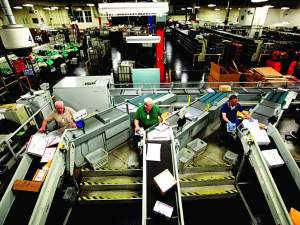
The closure USPS facilities across the country, like the San Bernardino Processing and Distribution Center, would eliminate jobs and increase delays in local postage.
The Chamber advised Congress and the United States Postal Service to keep the San Bernardino Mail Processing and Distribution Center in Redlands open amidst a series potential closures announced by the postal service in late 2011. More than 750 positions at the center employ residents across Inland Southern California and the closure of the center would result in mail from Riverside and San Bernardino Counties traveling to Los Angeles, Orange, or San Diego Counties before proceeding to their intended destinations.
With an increasing focus on tightening government budgets, the Chamber understands the need to modernize the postal system in a world of electronic communication. However, the decisions of where and how to make these reductions should be weighed against the potential economic impacts of eliminating jobs in the service as well as the effect of time delays that rerouting the distribution will have on each facility’s service area.
Among the list of endangered facilities, noticeably absent were four locations in Los Angeles and two locations in Santa Ana and Anaheim that are only 18 miles apart. If the San Bernardino Center were shuttered, mail from Riverside and San Bernardino Counties would conceivably be directed to Los Angeles, Orange County or San Diego, even if the final destination is back in Inland Southern California.
As Sharon Tyrrell of Capree Escrow, Inc. notes, the impact of this redirect would immediately impact local businesses, “We are seeing a slowdown in our mail now, with some packages taking six business days to arrive in a fairly local area. Using overnight services causes the cost for me and my clients to rise, but in many cases we have no choice.” Especially, in particular industries, advances in technology do not alleviate the situation as original signature documents are still required and cannot be done via e-sign.
In response to several legislative requests, the U.S. Postal Service agreed to delay the closing or consolidation of any mail processing facility until May 15, 2012, after opportunities for public input.
Chamber Insists Local Control Vital for ONT International Airport
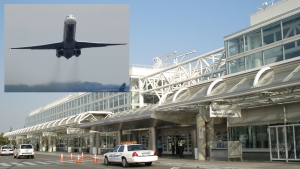
Higher rates and fewer flights have driven millions of travelers from Ontario to Los Angeles and other regional airports, resulting in large losses to the region’s economy.
With a unanimous vote by its Board of Directors, the Chamber joined a broad coalition of stakeholders to urge Los Angeles World Airports (LAWA) to cede control and management of Ontario International Airport (ONT) to a local agency based in Inland Southern California. As the region’s most accessible international airport and a critical asset to the region’s economy, ONT has seen lower passenger traffic as airlines are forced to charge higher rates or cut flights, driving passengers to Los Angeles International Airport (LAX).
Since August 2007, the number of flights available at the Ontario International Airport has dropped 47 percent and the number of destinations available to fly into has been cut by nearly 60%. The airport has seen travel drop by a third over the past four years, to less than 5 million passengers annually – a level last seen in 1988 – but fares for flights that remain are at prices well higher at than other Southern California airports.
The reduction of flights has also resulted in an upward cost spiral for airlines serving Ontario as more of the airport’s fixed-costs for operations have to be spread across fewer and fewer flights. Airline fees at Ontario last year averaged $14.50 per passenger, about seven times the fees at Burbank, twice those at Long Beach, 45% more than Orange County and 31% higher than LAX’s $11 fee. Despite efforts to trim the fee, the airport remains far more expensive than others in Southern California, and it continues to be burdened by an annual administration fee from LAWA of approximately $9 million.
While both the Los Angeles and Inland economies have been struggling for these past three years, airline flights through Los Angeles International Airport have been climbing steadily, while flights through Ontario have been collapsing in a descent outpacing the struggling economy. Under current management by LAWA, it is estimated that the local regional economy has lost approximately 8,000 airport-related jobs and $400 million in yearly business activity.
Despite the tough economy, aviation industry experts estimate that 2 million passengers a year are being forced to drive to Los Angeles or other regional airports to get the flights, connections and/or fares they need but no longer have access to at ONT. It is further estimated that this diversion of business results in as many as 1 million car trips to LAX or other regional airports, which means more traffic congestion and air pollution in Southern California.
The Chamber will continue to advocate for the establishment of local control of ONT to revive the regional airport as an effective tool for business, travel, and accessibility for Inland Southern California.
Chamber to Analyze Effects of Redrawing City Wards
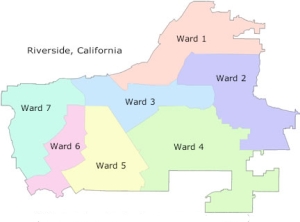
With significant growth in the City of Riverside since the 2000 Census, the City Council will soon begin reshaping ward boundaries to ensure that each ward contains a substantially equal number of residents.
Fresh off the recent run-off election for Ward 7 this past November, the Riverside City Council will soon begin redrawing their ward boundaries to reflect the growth in the City of Riverside and shifts in population among the seven wards. The resulting changes will likely have lasting impacts on future municipal governance in the City and ensure that representation reflects the growth of residents and businesses in the community. The Chamber will monitor the process to ensure that the business community is well-represented in any changes to the ward boundaries.
The Riverside City Charter provides that the boundaries of wards shall be reviewed at least every ten years after the completion of the federal census and that the boundaries of each ward shall contain a substantially equal number of residents. The Riverside City Charter states that the boundaries of each ward shall include a substantially equal number of residents and new boundaries cannot effectively cut a Councilmember out of their ward during their elected term. According to the 2010 Census, the population of the City of Riverside is 303,864 residents, demonstrating a marked growth from the 2000 census total of 255,166. Therefore, under optimal conditions, each city ward should contain 43,409 residents.
Following the redistricting process undertaken in 2002, the City Council adopted a set of criteria for developing new boundaries including: 1) equalizing the population count in each ward within 10%; 2) achieving within 5% from optimal population per ward; 3) complying with all applicable laws; 4) avoiding disqualification of City Councilmembers during a term; 5) maintaining continuity of existing wards to the extent possible; 6) drawing wards that are compact and contiguous; 7) using natural geographic boundaries to the extent possible; 8) maintaining cohesive neighborhoods and community interests to the extent possible; 9) considering school districts and avoiding division to the extent possible; and 10) maintaining income diversity within wards to the extent possible.
The City Council’s Governmental Affairs Committee will begin public meetings and deliberations of alternatives in March 2012 with the intention of introducing and adopting an ordinance to amend ward boundaries in June 2012.

A $20 million federal grant from the U.S. Department of Transportation will contribute towards the financing of the SR-91 Corridor Improvement Project, as part of an effort to reduce congestion on one of the most heavily traveled routes in Southern California.
The United States Department of Transportation awarded $20 million in federal funds to contribute towards the financing of corridor improvements along the 91 freeway, creating thousands of jobs in inland Southern California. This announcement is only a recent success as part of the ongoing process to ensure that the federal government provides the necessary financing the fund the entire $1.3 billion project.
With the strong support and collaboration between the Chamber, the Monday Morning Group, and several federal legislators, the Riverside County Transportation Commission (RCTC) was awarded the grant via the Transportation Investment Generating Economic Recovery (TIGER) program, a part of the Transportation Infrastructure Finance and Innovation Act (TIFIA), for the State Route 91 Corridor Improvement Project.
The selection process was highly competitive due to an enormous need for improving infrastructure and goods movement across the nation coupled with a shortage of funding for transportation at the federal level. “This would not have been possible and this project would not have had this success to date but for the continued support of Senators Dianne Feinstein (CA) and Barbara Boxer (CA) as well as Representatives Ken Calvert (CA-44), Jerry Lewis (CA-41), Mary Bono Mack (CA-45), and Gary Miller (CA-42),” said Cindy Roth, Chamber President and CEO.
A recent study by Beacon Economics indicates that the net economic and time savings benefit of the project will exceed $3.2 billion and create as many as 16,000 jobs during the five-year time-span of construction. The overall length of construction will be considerably shortened through the use of design-build contracting, approved specifically for this project by state legislation. Other estimates, which included service jobs created by the road workers spending money, said the work could bring about 16,000 jobs between now and 2017.
The SR-91 project focuses on reducing congestion on one of the most heavily traveled freeways in Southern California by extending the 91 Express Lanes into Riverside County, adding a new lane in each direction of the SR-91, rebuilding seven interchanges, making needed street and access improvements in the city of Corona, and constructing a number of auxiliary lanes at key locations to ease access on and off the freeway. The toll lanes will also enable RCTC to work with the Riverside Transit Agency to expand express bus service along the corridor.
Nevertheless, this grant will leverage part of a $445 million TIFIA loan needed from the U.S. Treasury to finance the SR-91 project (one-third of the project’s cost).Though the $20 million does not provide all the federal backing that RCTC needs for the $1.3 billion freeway widening, the grant is encouraging, said Anne Mayer, RCTC Executive Director of the Riverside County Transportation Commission. The Chamber and other community groups will continue to advocate for the necessary financing to ensure that this project begins and finishes construction on time.